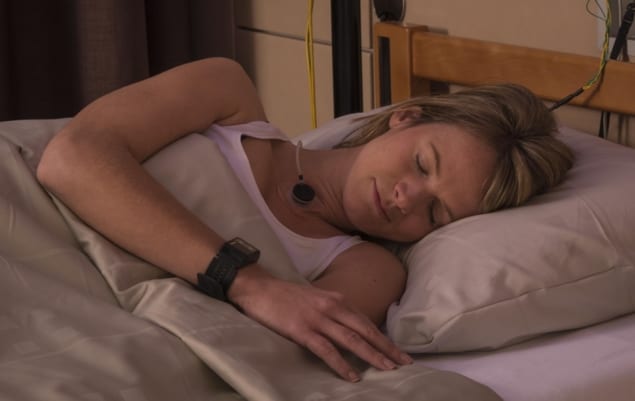
Assessing respiratory activity during sleep is a vital step in diagnosing sleep-related breathing disorders. In clinical practice, this is performed via respiratory inductance plethysmography (RIP), which measures breathing-induced volume variations using belts around the abdomen or thorax. This is, however, an obtrusive approach that only measures movements of a single specific body part.
The increasing prevalence of smart-watches and fitness trackers holds promise for reducing both the obtrusiveness and cost of sleep monitoring. Many of these wearable devices employ reflective green light photoplethysmography (PPG) to measure blood volume variations. PPG pulses contain information about changes in peripheral blood flow generated by various physiological processes – including respiration.
“The PPG respiratory component is caused by the intrathoracic pressure variation resulting from the overall respiratory activity,” explains Gabriele Papini from Eindhoven University of Technology (TU/e). “And while RIP can measure only respiration, PPG can also measure cardiovascular activity. It is an ideal sleep monitoring candidate because it allows continuous long-term monitoring and it is rich in physiological information.”
Papini and colleagues – from Eindhoven MedTech Innovation Center (e/MTIC), Philips Research and Sleep Medicine Center Kempenhaeghe – have now developed and tested a respiratory activity surrogate (RAS) obtained from wrist-worn reflective PPG signals. Writing in Physiological Measurement, they showed that this surrogate compares well with a reference thoracic RIP signal.
Sleep study
To validate the PPG-RAS, the researchers examined 389 sleep recordings from a sleep-disordered population, including 226 patients with obstructive sleep apnoea, 108 with insomnia and 45 with sleep movement disorders. Patients wore a wrist-worn device containing a green-light reflective PPG sensor and a three-axial accelerometer to record motion data.
To extract the PPG-RAS from the recorded data, the team used a four-stage method: PPG pulse segmentation; identification of landmarks on the pulses; pulse-by-pulse quality evaluation; and calculation of surrogate respiratory activity from the reliable landmarks.
Following segmentation and rejection of any low-quality pulses, the researchers identified four landmarks in each pulse: the foot (starting point), end (endpoint), systolic peak (maximum) and diastolic peak (second inflection point after the systolic peak). They found that the distance between the foot and the systolic peak produced the PPG-RAS with the best breathing rate estimation performance.
To assess the overall PPG signal quality, they divided the signals into 30 s time periods (epochs) and calculated the median pulse quality index over each epoch. A second quality indicator assessed the ratio between the sum of the interbeat intervals divided by the epoch duration.
Surrogate accuracy
Using the foot–systolic peak measurements, the team compared the calculated PPG-RAS with reference respiratory activity signals measured using thoracic RIP. Quantifying the similarity between the reference RIP signal and the PPG-RAS in the time and frequency domains demonstrated good agreement between the two, with respiration rate estimation in line with published results from other types of PPG sensors.

The researchers next evaluated the impact of PPG signal quality and patient motion. They found that the similarity between the reference signal and the PPG-RAS increased with increasing signal quality, because more high-quality pulses are available to calculate the surrogate. Although most epochs had low motion levels, movement decreased the similarity and for medium-to-high movement levels, the similarity was weak. This confirms that it is easier to accurately capture respiratory activity during quieter sleep.
“A few low-quality pulses have a negligible impact on the RAS estimation if they are removed. But if the RAS is estimated on a group of pulses with an average low pulse quality, it is likely to not be accurate,” Papini explains. “This might be due to a low amount of pulses available after single-pulse rejection or the overall quality of the pulses being low.”
To mitigate the effects of low pulse quality or high motion levels, the team proposed three post-processing steps. These steps exclude any 30 s epochs with a median pulse quality index lower than 0.8, any with an interbeat interval coverage lower than 66%, and any with activity counts higher than 21. Applying these steps improved the similarity between the reference signal and the PPG-RAS. Each step, however, caused a drop in coverage (of 5%, 6%, and 17%, respectively) and some recordings had a low number of epochs after applying all post-processing steps.

Making health digital
Finally, the group examined the impact of sleep stage and obstructive sleep apnoea severity on PPG-RAS accuracy. The lowest performance was observed in waking epochs, followed by stage N1 sleep (transition between wake and sleep). Epochs from participants with severe obstructive sleep apnoea exhibited the lowest similarity between reference signal and PPG-RAS. In all cases, post-processing significantly increased performance.
The researchers conclude that wrist-worn PPG can enable respiration monitoring in real-world sleep medicine applications using consumer wearable devices. They are now using the PPG-RAS together with cardiovascular features such as heart rate variability to monitor obstructive sleep apnoea using wrist-worn devices. “Another topic is improving the RAS and comparing it with respiratory effort measurements, i.e., changes in intrathoracic pressure due to respiration, since these are closely related to obstructive sleep apnoea presence,” Papini tells Physics World.



